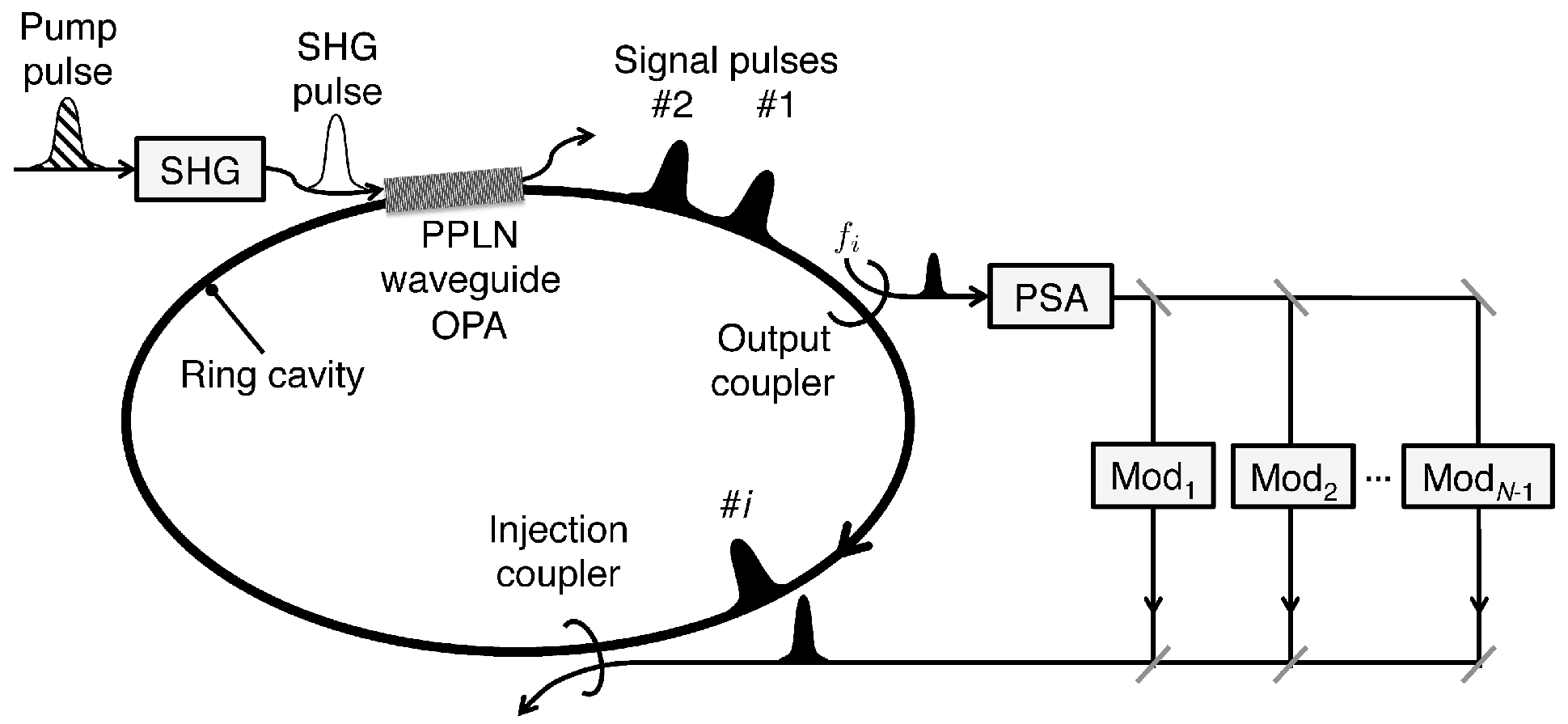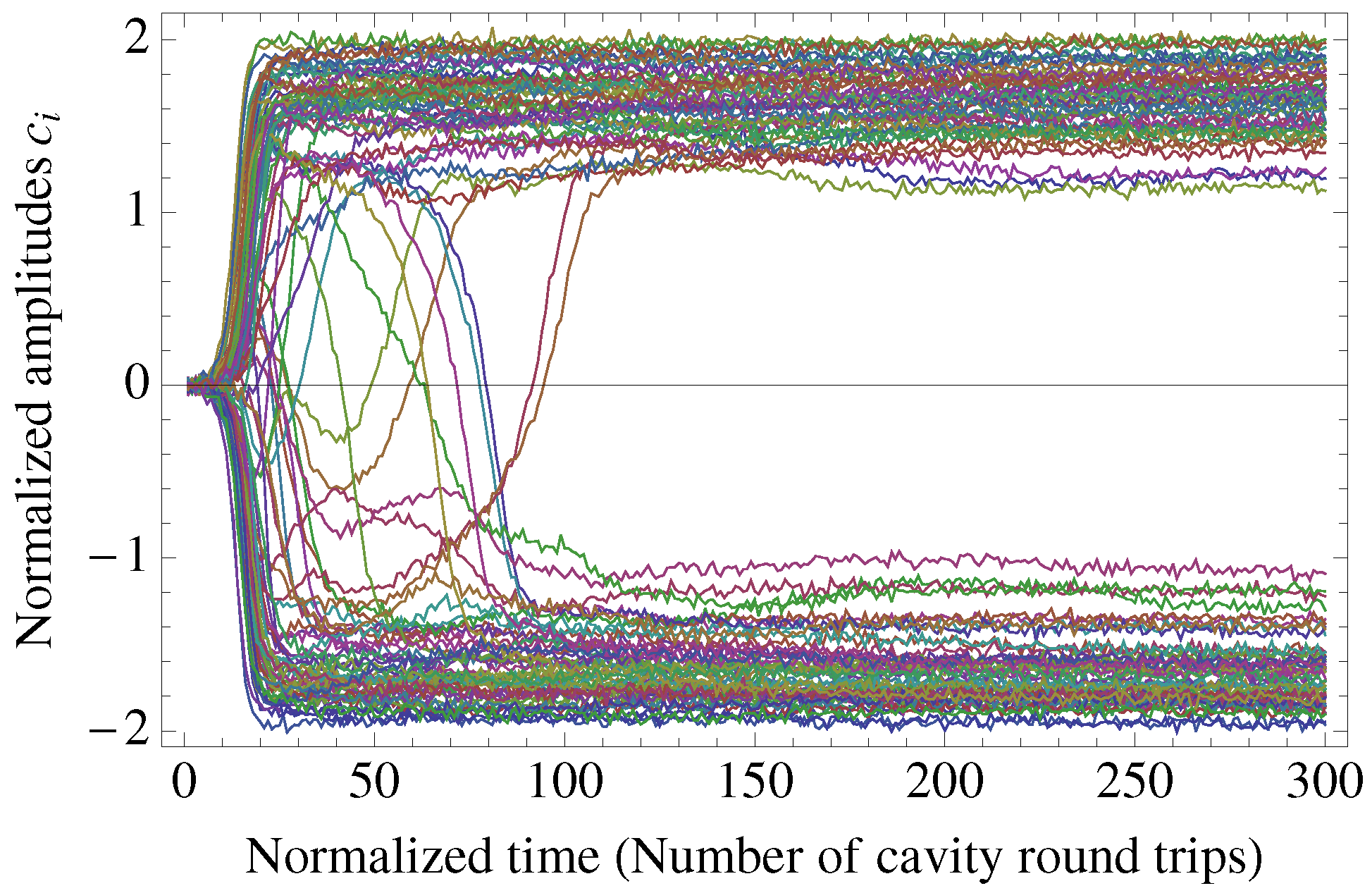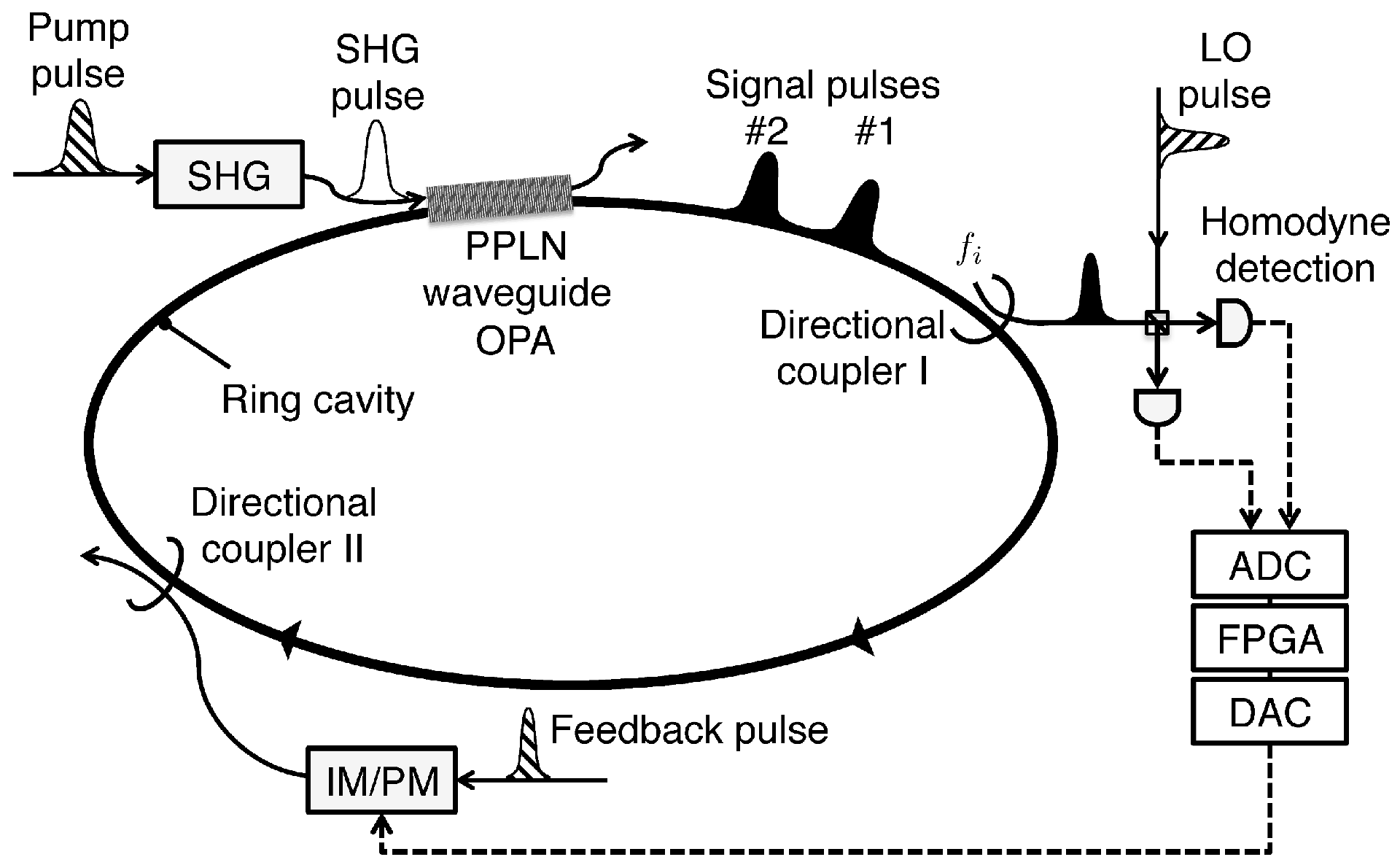Computational Principle and Performance Evaluation of Coherent Ising Machine Based on Degenerate Optical Parametric Oscillator Network
Abstract
:1. Introduction
2. Principle
2.1. A Proposed Machine
2.2. Quantum Search, Quantum Filtering, and Quantum-to-Classical Crossover
- Quantum parallel searchEach DOPO pulse is in a linear superposition state, but there is no correlation between different DOPO pulses established yet immediately after the pump pulse is switched-on:However, the probability amplitudes for spin eigenstates start searching for the ground state of the Ising Hamiltonian via mutual coupling.
- Quantum filteringThe probability amplitudes of the two degenerate ground states are amplified, while those of the excited states are deamplified when the pump rate is approaching to the oscillation threshold:where is a small constant. It is numerically founed that such filtering of a quantum entangled state is formed even when the average photon number per DOPO is much smaller than one [34]. A minute energy injected into the system still realized the quantum parallel search and quantum filtering, which promises the success of computation.
- Spontaneous symmetry breakingAt the critical point of the DOPO threshold, random spontaneous emission noise selects one of the two degenerate ground states with equal probabilities. For instance, the probability amplitude of state is amplified but that for the state is deamplified at this stage in one particular run, and vice versa in another run.
- Quantum-to-classical crossoverWith increasing the pump rate well above the threshold, the chosen spin state dominates over all the other spin states including the other ground state via pump depletion (cross-gain saturation). The quantum state of each DOPO approaches a high excited coherent state with 0-phase or π-phase, which is the closest analog for the classical electromagnetic field.
2.3. Quantum Theory of Coherent Ising Machines
3. Working Equations
3.1. c-Number Stochastic Differential Equations for Multiple-Pulse DOPO with Mutual Coupling
3.2. Turn-on Delay Time
4. Numerical Simulations
5. Discussion
5.1. Measurement-Feedback Control
5.2. Application to Various Problems
- Via MAX-2-SATMAX-2-SAT is a problem to find an assignment for a given 2-CNF which satisfies as many clauses as possible. We can construct a CNF of MAX-2-SAT from a given 3-CNF S with using an auxiliary literal for each clause [1]:whereFor each , we can satisfy exactly seven within 10 clauses if the original is satisfiable. If not, the satisfiable clauses in is six. Hence, 7 m within 10 m clauses in can be satisfied simultaneously if and only if the given CNF S is satisfiable. The 3-SAT became a MAX-2-SAT with variables and 10 m clauses. Then, it is easily converted to QUBO as replacing the literal to a variable , the negation of literal to , respectively , and the clauses to AND operation of variables [40]:whose ground state energy is if and only if it is satisfiable.
- Via Maximum independent set (MIS)3-SAT can be described in terms of MIS on a graph with vertices. The graph can be constructed to connect the contradicting literals in m triangle graphs (each triangle graph represent a clause). Then there exist independent sets of size m, if and only if the original 3-CNF is satisfiable. Since the MIS is mapped to an Ising problem with the equivalent number of vertices [41], 3-SAT becomes -spin Ising problem in this case. The Ising coupling term takes only in this case.
- Via 3-body problem3-SAT is easily interpreted as an optimization problem which has cost function with up to 3-body interactionswhere the coefficients are given from literals in 3-CNFand represent boolean values. To replace the 3-body term with the 2-body interaction, we introduce an auxiliary spin , which keeps with the penalty term [42]:where is a penalty strength. Then, the summation ofover gives the 2-body Hamiltonian with the ground state of energy 0.
6. Conclusions
Acknowledgments
Author Contributions
Conflicts of Interest
Abbreviations
| CIM | Coherent Ising machine |
| DOPO | Degenerate optical parametric oscillator |
| NP | Non-deterministic polynomial-time |
| MAX-CUT | Maximum cut problem |
| GW | Goemans–Williamson |
| SA | Simulated annealing |
| SG | Sahni–Gonzalez |
| BLS | Breakout local search |
| CSDE | c-number stochastic differential equation |
| SHG | Second harmonic generation |
| PSA | Phase sensitive amplifier |
| FPGA | Field programmable gate array |
| ASIC | Application specific integrated circuit |
| QUBO | Quadratic unconstrained binary optimization |
| SAT | Boolean satisfiability problem |
| CNF | Conjunctive normal form |
| MIS | Maximum independent set |
| TSP | Traveling salesman problem |
References
- Garey, M.R.; Johnson, D.S. Computers and Intractability: A Guide to the Theory of NP-Completeness; Freeman: San Francisco, CA, USA, 1979. [Google Scholar]
- Barahona, F.J. On the computational complexity of Ising spin glass models. Phys. A 1982, 15, 3241–3253. [Google Scholar] [CrossRef]
- Karp, R.M. Complexity of Computer Computations; Millera, R.E., Thatcher, J.W., Eds.; Plenum: New York, NY, USA, 1972; pp. 85–103. [Google Scholar]
- Mézard, M.; Parisi, G.; Virasoro, M. Spin Glass Theory and Beyond; World Scientific: Singapore, Singapore, 1987. [Google Scholar]
- Kitchen, D.B.; Decornez, H.; Furr, J.R.; Bajorath, J. Docking and scoring in virtual screening for drug discovery: Methods and applications. Nat. Rev. Drug Discov. 2004, 3, 935–949. [Google Scholar] [CrossRef] [PubMed]
- Nishimori, H. Statistical Physics of Spin Glasses and Information Processing; Oxford University Press: Oxford, UK, 2001. [Google Scholar]
- Orlova, G.I.; Dorfman, Y.G. Finding the maximum cut in a graph. Eng. Cybern. 1972, 10, 502–506. [Google Scholar]
- Hadlock, F. Finding a Maximum Cut of a Planar Graph in Polynomial Time. SIAM J. Comput. 1975, 4, 221–225. [Google Scholar] [CrossRef]
- Grötschel, M.; Pulleyblank, W.R. Weakly bipartite graphs and the Max-cut problem. Oper. Res. Lett. 1981, 1, 23–27. [Google Scholar] [CrossRef]
- Grötschel, M.; Nemhauser, G.L. A polynomial algorithm for the max-cut problem on graphs without long odd cycles. Math. Program. 1984, 29, 28–40. [Google Scholar] [CrossRef]
- Galluccio, A.; Loebl, M.; Vondrák, J. Optimization via enumeration: A new algorithm for the Max Cut Problem. Math. Program. 2001, 90, 273–290. [Google Scholar] [CrossRef]
- Arora, S.; Lund, C.; Motwani, R.; Sudan, M.; Szegedy, M. Proof verification and the hardness of approximation problems. J. ACM 1998, 45, 501–555. [Google Scholar] [CrossRef]
- Håstad, J. Some optimal inapproximability results. J. ACM 2001, 48, 798–859. [Google Scholar] [CrossRef]
- Goemans, M.X.; Williamson, D.P. Improved approximation algorithms for maximum cut and satisfiability problems using semidefinite programming. J. ACM 1995, 42, 1115–1145. [Google Scholar] [CrossRef]
- Kirkpatrick, S.; Gelatt, C.D., Jr.; Vecchi, M.P. Optimization by Simulated Annealing. Science 1983, 220, 671–680. [Google Scholar] [CrossRef] [PubMed]
- Kadowaki, T.; Nishimori, H. Quantum annealing in the transverse Ising model. Phys. Rev. E 1998, 58, 5355–5363. [Google Scholar] [CrossRef]
- Santoro, G.E.; Martoňák, R.; Tosatti, E.; Car, R. Theory of Quantum Annealing of an Ising Spin Glass. Science 2002, 295, 2427–2430. [Google Scholar] [CrossRef] [PubMed]
- Farhi, E.; Goldstone, J.; Gutmann, S.; Lapan, J.; Lundgren, A.; Preda, D. A Quantum Adiabatic Evolution Algorithm Applied to Random Instances of an NP-Complete Problem. Science 2001, 292, 472–475. [Google Scholar] [CrossRef] [PubMed]
- Van Dam, W.; Mosca, M.; Vazirani, U.V. How powerful is adiabatic quantum computation? In Proceedings of the 42nd IEEE Symposium on Foundations of Computer Science; IEEE Computer Society: Los Alamitos, CA, USA, 2001; pp. 279–287. [Google Scholar]
- Aharonov, D.; van Dam, W.; Kempe, J.; Landau, Z.; Lloyd, S.; Regev, O. Adiabatic Quantum Computation Is Equivalent to Standard Quantum Computation. SIAM J. Comput. 2008, 50, 755–787. [Google Scholar] [CrossRef]
- Sahni, S.; Gonzalez, T. P-Complete Approximation Problems. J. ACM 1976, 23, 555–565. [Google Scholar] [CrossRef]
- Kahruman, S.; Kolotoglu, E.; Butenko, S.; Hicks, I.V. On greedy construction heuristics for the MAX-CUT problem. Int. J. Comput. Sci. Eng. 2007, 3, 211–218. [Google Scholar] [CrossRef]
- Benlic, U.; Hao, J.-K. Breakout Local Search for the Max-Cutproblem. Eng. Appl. Artif. Intel. 2013, 26, 1162–1173. [Google Scholar] [CrossRef] [Green Version]
- Utsunomiya, S.; Takata, K.; Yamamoto, Y. Mapping of Ising models onto injection-locked laser systems. Opt. Express 2011, 19, 18091–18108. [Google Scholar] [CrossRef] [PubMed]
- Takata, K.; Utsunomiya, S.; Yamamoto, Y. Transient time of an Ising machine based on injection-locked laser network. New J. Phys. 2012, 14, 013052–013073. [Google Scholar] [CrossRef]
- Takata, K.; Yamamoto, Y. Data search by a coherent Ising machine based on an injection-locked laser network with gradual pumping or coupling. Phys. Rev. A 2014, 89, 032319. [Google Scholar] [CrossRef]
- Utsunomiya, S.; Namekata, N.; Takata, K.; Akamatsu, D.; Inoue, S.; Yamamoto, Y. Binary phase oscillation of two mutually coupled semiconductor lasers. Opt. Express 2015, 23, 6029–6040. [Google Scholar] [CrossRef] [PubMed]
- Wang, Z.; Marandi, A.; Wen, K.; Byer, R.L.; Yamamoto, Y. Coherent Ising machine based on degenerate optical parametric oscillators. Phys. Rev. A 2013, 88, 063853. [Google Scholar] [CrossRef]
- Marandi, A.; Wang, Z.; Takata, K.; Byer, R.L.; Yamamoto, Y. Network of time-multiplexed optical parametric oscillators as a coherent Ising machine. Nat. Photon. 2014, 8, 937–942. [Google Scholar] [CrossRef]
- Takata, K. Quantum theory and Experimental Demonstration of a Coherent Computing System with Optical Parametric Oscillators. Ph.D. Thesis, the University of Tokyo, Tokyo, Japan, 2015. [Google Scholar]
- Inagaki, T. Large-scale Ising spin network based on degenerate optical parametric oscillator. Nat. Phys. 2016, in press. [Google Scholar]
- Drummond, P.D.; Gardiner, C.W.J. Generalised P-representations in quantum optics. Phys. A 1980, 13, 2353–2368. [Google Scholar] [CrossRef]
- Takata, K.; Marandi, A.; Yamamoto, Y. Quantum correlation in degenerate optical parametric oscillators with mutual injections. Phys. Rev. A 2015, 92, 043821. [Google Scholar] [CrossRef]
- Maruo, D.; Utsunomiya, S.; Yamamoto, Y. Truncated Wigner theory of coherent Ising machines based on degenerate optical parametric oscillator network. Phys. Scripta 2016, in press. [Google Scholar]
- Drummond, P.D.; McNeil, K.J.; Walls, D.F. Non-equilibrium Transitions in Sub/Second Harmonic Generation II. Quantum theory. Opt. Acta 1981, 28, 211–225. [Google Scholar] [CrossRef]
- Glauber, R.J. Coherent and Incoherent States of the Radiation Field. Phys. Rev. 1963, 131. [Google Scholar] [CrossRef]
- Carmichael, H. Statistical Methods in Quantum Optics 1: Master Equations and Fokker-Planck Equations; Springer: Berlin, Germany, 1999. [Google Scholar]
- Kinsler, P.; Drummond, P.D. Quantum dynamics of the parametric oscillator. Phys. Rev. A 1991, 43, 6194–6208. [Google Scholar] [CrossRef]
- Haribara, Y.; Utsunomiya, S.; Kawarabayashi, K.; Yamamoto, Y. Encyclopedia of Spectroscopy and Spectrometry, 3rd ed.; Elsevier: Oxford, UK, 2016. [Google Scholar]
- Santra, S.; Quiroz, G.; Steeg, G.V.; Lidar, D.A. Dynamically probing ultracold lattice gases via Rydberg molecules. New J. Phys. 2015, 17, 103024. [Google Scholar]
- Lucas, A. Ising formulations of many NP problems. Front. Phys. 2014, 2, 5. [Google Scholar] [CrossRef]
- Perdomo-Ortiz, A.; Dickson, N.; Drew-Brook, M.; Rose, G.; Aspuru-Guzik, A. Finding low-energy conformations of lattice protein models by quantum annealing. Sci. Rep. 2012, 2. [Google Scholar] [CrossRef] [PubMed]





| Method/Algorithm | Graph Order | ||||
|---|---|---|---|---|---|
| 40 | 160 | 800 | 4000 | 20,000 | |
| GW | 0.00345 | 0.170 | 22.5 | ||
| SA | 0.00906 | 0.020 | 1.30 | 10.2 | 210 |
| BLS | 0.0255 | 0.0465 | 1.22 | 52.3 | |
| SG3 | – | – | – | 0.592 | 15.3 |
| CIM | 0.00297 | 0.00256 | 0.00040 | 0.00055 | 0.00199 |
| Fiber (km) | Repetition (GHz) | Time (s) | |
|---|---|---|---|
| 0.2 | 2 | 2000 | |
| 2 | 2 | ||
| 20 | 2 | 0.01 | |
| 20 | 20 | 0.01 | |
| 20 | 200 | 0.01 |
| Original Problem | Complexity Class | N |
|---|---|---|
| MAX-CUT | NP-hard | n |
| Graph coloring | NP-hard | |
| Maximum clique | NP-hard | n |
| MIS | NP-hard | n |
| Minimum vertex cover | NP-hard | n |
| Maximum set packing | NP-hard | #subsets |
| TSP | NP-hard | |
| Hamiltonian path | NP-complete | |
| Graph isomorphism | NP | n |
| -norm regularization | NP-hard | |
| 3-SAT via MAX-2-SAT | NP-complete | |
| 3-SAT via MIS | NP-complete | |
| 3-SAT via 3-body | NP-complete | |
| 3-SAT (3-body in FPGA) | NP-complete | n |
© 2016 by the authors; licensee MDPI, Basel, Switzerland. This article is an open access article distributed under the terms and conditions of the Creative Commons Attribution (CC-BY) license (http://creativecommons.org/licenses/by/4.0/).
Share and Cite
Haribara, Y.; Utsunomiya, S.; Yamamoto, Y. Computational Principle and Performance Evaluation of Coherent Ising Machine Based on Degenerate Optical Parametric Oscillator Network. Entropy 2016, 18, 151. https://doi.org/10.3390/e18040151
Haribara Y, Utsunomiya S, Yamamoto Y. Computational Principle and Performance Evaluation of Coherent Ising Machine Based on Degenerate Optical Parametric Oscillator Network. Entropy. 2016; 18(4):151. https://doi.org/10.3390/e18040151
Chicago/Turabian StyleHaribara, Yoshitaka, Shoko Utsunomiya, and Yoshihisa Yamamoto. 2016. "Computational Principle and Performance Evaluation of Coherent Ising Machine Based on Degenerate Optical Parametric Oscillator Network" Entropy 18, no. 4: 151. https://doi.org/10.3390/e18040151
APA StyleHaribara, Y., Utsunomiya, S., & Yamamoto, Y. (2016). Computational Principle and Performance Evaluation of Coherent Ising Machine Based on Degenerate Optical Parametric Oscillator Network. Entropy, 18(4), 151. https://doi.org/10.3390/e18040151





